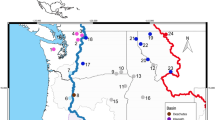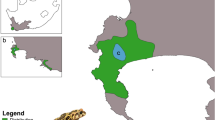Abstract
Reduced, or bottlenecked, populations are more prone to adverse events. Thus, the detection of genetic bottleneck signatures in wildlife is an important issue for conservation. BOTTLENECK 1.2.02 is a software commonly used for detecting genetic characteristics of past bottlenecks. Here we test the efficiency with which this software detects bottlenecks in two koala populations of known history. The sign test performed well for both populations, particularly under the infinite alleles model for mutation. This suggests this model could be the more realistic for marsupial microsatellites than other mutation models. Under the allele frequency distribution test, the two populations falsely appeared to be at mutation/drift equilibrium. However, this test could detect the bottleneck when only imperfect repeat microsatellites were included in the analysis. We thus recommend further investigation of imperfect repeat microsatellites, which could be more powerful for bottleneck detection. These results underline the cautious approach researchers and conservationists should take when studying the past of unknown populations.

Similar content being viewed by others
Abbreviations
- IAM:
-
Infinite alleles model
- SMM:
-
Stepwise mutation model
- TPM:
-
Two phase model
References
Amos W, Balmford A (2001) When does conservation genetics matter? Heredity 87:257–265
Bijlsma R, Bundgaard J, Boerema AC (2000) Does inbreeding affect the extinction risk of small populations?: predictions from Drosophila. J Evol Biol 13(3):502–514
Bouzat JL, Cheng HH, Lewin HA et al (1998) Genetic evaluation of a demographic bottleneck in the greater prairie chicken. Conserv Biol 12(4):836–843
Brook BW, Tonkyn DW, O’Grady JJ et al (2002) Contribution of inbreeding to extinction risk in threatened species. Conserv Ecol 6(1):16. Available from http://www.consecol.org/vol16/iss11/art16
Chakraborty R, Nei M (1977) Bottleneck effects on average heterozygosity and genetic distance with stepwise mutation model. Evolution Int J org Evolution 31(2):347–356
Cornuet JM, Luikart G (1996) Description and power analysis of two tests for detecting recent population bottlenecks from allele frequency data. Genetics 144(4):2001–2014
Cristescu R, Cahill V, Handasyde K et al (2009) Inbreeding and testicular abnormalities in a bottlenecked population of koalas, Phascolarctos cinereus. Wildl Res 36(4):299–308
Di Rienzo A, Peterson AC, Garza JC et al (1994) Mutational processes of simple-sequence repeat loci in human populations. Proc Natl Acad Sci U S A 91(8):3166–3170
Frankham R (2005) Genetics and extinction. Biol Conserv 126(2):131–140
Garza JC, Williamson EG (2001) Detection of reduction in population size using data from microsatellite loci. Mol Ecol 10(2):305–318
Gibson M, Irvin M (2003) Tree condition assessment of selected sites on French Island. Report to Parks Victoria, Melbourne, Centre for Environmental Management University of Ballarat, p 47
Goldstein DB, Clark AG (1995) Microsatellite variation in North American populations of Drosophila melanogaster. Nucleic Acids Res 23(19):3882–3886
He W, Lin L, Shen F et al (2008) Genetic diversities of the giant panda (Ailuropoda melanoleuca) in Wanglang and Baoxing nature reserves. Conserv Genet 9(6):1541–1546
Hedrick P, Miller P (1992) Conservation genetics: techniques and fundamentals. Ecol Appl 2:30–46
Hoelzel AR, Halley J, O’Brien SJ et al (1993) Elephant seal genetic variation and the use of simulation models to investigate historical population bottlenecks. J Hered 84(6):443–449
Houlden BA, England P, Sherwin WB (1996a) Paternity exclusion in koalas using hypervariable microsatellites. J Hered 87(2):149–152
Houlden BA, England PR, Taylor AC et al (1996b) Low genetic variability of the koala Phascolarctos cinereus in south-eastern Australia following a severe population bottleneck. Mol Ecol 5(2):269–281
Hull J, Anderson R, Bradbury M et al (2008) Population structure and genetic diversity in Swainson’s Hawks (Buteo swainsoni): implications for conservation. Conserv Genet 9(2):305–316
Jimenez JA, Hughes KA, Alaks G et al (1994) An experimental study of inbreeding depression in a natural habitat. Science 266(5183):271–273
Lande R (1994) Risk of population extinction from fixation of new deleterious mutations. Evolution Int J org Evolution 48:1460–1469
Le Page SL, Livermore RA, Cooper DW et al (2000) Genetic analysis of a documented population bottleneck: introduced Bennett’s wallabies (Macropus rufogriseus rufogriseus) in New Zealand. Mol Ecol 9(6):753–763
Luikart G, Cornuet JM (1998) Empirical evaluation of a test for identifying recently bottlenecked populations from allele frequency data. Conserv Biol 12(1):228–237
Luikart G, Allendorf FW, Cornuet JM et al (1998) Distortion of allele frequency distributions provides a test for recent population bottlenecks. J Hered 89(3):238–247
Lynch M, Conery J, Burger R (1995) Mutation accumulation and the extinction of small populations. Am Nat 146(4):489–518
Madsen T, Stille B, Shine R (1996) Inbreeding depression in an isolated population of adders Vipera berus. Biol Conserv 75(2):113–118
Martin RW (1981) Age-specific fertility in three populations of the koala, Phascolarctos cinereus Goldfuss, in Victoria. Wildl Res 8(2):275–283
Martin R, Handasyde K (1999) The koala: natural history, conservation and management, Australian natural history series. University of New South Wales Press Ltd., Hong Kong
Maruyama T, Fuerst PA (1985) Population bottlenecks and nonequilibrium models in population genetics, II. Number of alleles in a small population that was formed by a recent bottleneck. Genetics 111(3):675–689
Masters P, Duka T, Berris S et al (2004) Koalas on Kangaroo Island: from introduction to pest status in less than a century. Wildl Res 31(3):267–272
Mills LS, Smouse PE (1994) Demographic consequences of inbreeding in remnant populations. Am Nat 144(3):412–431
Nei M (1987) Molecular evolutionary genetics. Colombia University Press, New York
Nei M, Li WH (1976) The transient distribution of allele frequencies under mutation pressure. Genet Res 28(3):205–214
Nei M, Maruyama T, Chakraborty R (1975) The bottleneck effect and genetic variability in populations. Evolution Int J org Evolution 29(1):1–10
Newman D, Pilson D (1997) Increased probability of extinction due to decreased genetic effective population size: experimental populations of Clarkia pulchella. Evolution Int J org Evolution 51(2):354–362
O’Brien SJ, Roelke ME, Marker L et al (1985) Genetic basis for species vulnerability in the cheetah. Science 227(4693):1428–1434
O’Brien SJ, Wildt DE, Bush M et al (1987) East African cheetahs: evidence for two population bottlenecks? Proc Natl Acad Sci 84(2):508–511
Ovenden JR, White RW (1990) Mitochondrial and allozyme genetics of incipient speciation in a landlocked population of Galaxias truttaceus (Pisces: Galaxiidae). Genetics 124(3):701–716
Packer C, Pusey AE, Rowley H et al (1991) Case study of a population bottleneck: lions of the Ngorongoro crater. Conserv Biol 5(2):219–230
Piry S, Luikart G, Cornuet JM (1999) BOTTLENECK: A computer program for detecting recent reductions in the effective population size using allele frequency data. J Hered 90(4):502–503
Schlötterer C (2000) Evolutionary dynamics of microsatellite DNA. Chromosoma 109(6):365–371
Schlötterer C, Tautz D (1992) Slippage synthesis of simple sequence DNA. Nucleic Acids Res 20(2):211–215
Sherwin WB, Murray ND (1990) Population and conservation genetics of marsupials. Aust J Zool 37(2–4):161–180
Taylor A, Sherwin W, Wayne R (1994) Genetic variation of microsatellite loci in a bottleneck species: the northern hairy nosed wombat Lasiorhinus krefftii. Mol Ecol 3:277–290
Thomas A, White JBS (2007) Genetic diversity and population size: island populations of the common shrew, Sorex araneus. Mol Ecol 16(10):2005–2016
Vazquez JF, Perez T, Albornoz J et al (2000) Estimation of microsatellite mutation rates in Drosophila melanogaster. Genet Res 76(3):323–326
Vucetich JA, Waite TA (1999) Erosion of heterozygosity in fluctuating populations. Conserv Biol 13(4):860–868
Weber JL (1990) Informativeness of human (Dc-Da)N.(Dg-Dt)N polymorphisms. Genomics 7(4):524–530
Whitehouse AM, Harley EH (2001) Post-bottleneck genetic diversity of elephant populations in South Africa, revealed using microsatellite analysis. Mol Ecol 10(9):2139–2149
Wierdl M, Dominska M, Petes TD (1997) Microsatellite instability in yeast: dependence on the length of the microsatellite. Genetics 146(3):769–779
Acknowledgments
This worked has been funded by ARC linkage grant (LPO560344). We thank K. Carlyon for providing koala samples, B. L. Carlsson and A. Wilton for technical assistance. We also thank the Rangers from French Island National Park (Parks Victoria) and the members of the Koala Management Program (Department for Environment and Heritage) for their support and assistance in the field. We would also like to thank two anonymous reviewers for their most helpful comments.
Author information
Authors and Affiliations
Corresponding author
Rights and permissions
About this article
Cite this article
Cristescu, R., Sherwin, W.B., Handasyde, K. et al. Detecting bottlenecks using BOTTLENECK 1.2.02 in wild populations: the importance of the microsatellite structure. Conserv Genet 11, 1043–1049 (2010). https://doi.org/10.1007/s10592-009-9949-2
Received:
Accepted:
Published:
Issue Date:
DOI: https://doi.org/10.1007/s10592-009-9949-2




